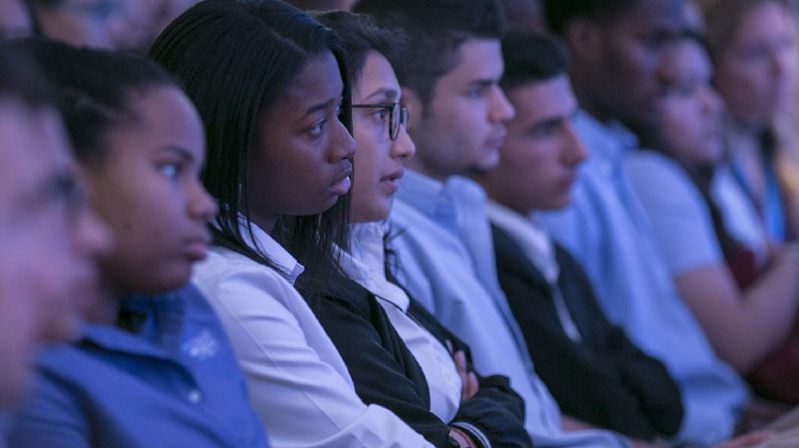Make a donation to the museum
Talking to Children About Terrorism
Terrorist attacks in the United States and around the world evoke strong emotions and questions in all of us.
For some, these events—which are typically broadcast widely and often with explicit imagery—can elicit emotions long forgotten. For others, these emotions are being felt for the first time. Attending to these reactions, while also conveying information about an event to our children and students, is no easy task.
The following tips have been prepared to provide broad guidelines to help you in these conversations. They are meant as a starting point. See the links below for other resources that can provide additional guidance.
Listen
Some children will want to talk about terrorism and some won’t. Both reactions are common. If they do want to talk, it’s important to offer children a safe space to share their thoughts and questions. Actively listen to their concerns, attend to their body language, validate their emotions, and encourage respectful conversation and discussions. If they don’t feel like talking, don’t force the discussions. Continue to check in and let them know you are ready to listen whenever they’re ready to talk.
Don’t Avoid Difficult Conversations
Parents and caregivers understandably don’t want to cause anxiety and distress in their children. This often results in shying away from difficult conversations that we presume will provoke these emotions. It is terrorism itself, though, that is upsetting, not the conversations about terrorism. Invite the conversation with open-ended questions, such as “What would you like to know?” or “How does this make you feel?” Let the child’s interests and thoughts guide the conversation.
Be Prepared
Be prepared for your children to ask questions about death when discussing terrorism, and to answer these questions in a way that is honest and developmentally appropriate. Reassure children of their safety. Be aware of your tone, remaining calm and not appearing anxious. Ask your children about their concerns and provide appropriate, realistic reassurance. If your children have persistent concerns, allow them to express those feelings. Focus on how to cope with troubling feelings rather than suggest their worries are unfounded. Share what is being done to keep them, their family members, and their friends safe.
Answer Questions about the Attacks with Facts
Children’s understanding of current events comes from the myriad of sources around them—their families, schools, friends, and media. As is often the case, these sources can sometimes contradict each other. It is important, then, to answer children’s questions about what happened with basic facts and age-appropriate language; don’t try to share all the information you know. Point older children to reliable sources of information for further research.

Acknowledge That We Don’t Have All the Answers
It’s all right not to know the answer to every question. Terrorism is a very complex subject. If you can’t answer your child’s question, be honest. Use the opportunity to model yourself as a learner, and explore the question together. Just like adults, children may also pose rhetorical questions—they may be looking for someone to acknowledge their concerns rather than provide an answer.
Be Specific
It can be easy to make generalizations when discussing terrorism. Avoid talking in broad strokes, comparing the suffering of one person to another, or assigning blame to an entire group. Highlight specific stories of the survivors, victims, or first responders to help humanize the event, and avoid stereotypes and simplifications.
Emotions Vary
Children’s responses to terrorist attacks will vary widely depending on their age, personality, nationality, actual or perceived ethnic or religious background, connection to the attacks, and exposure to other past traumatic experiences. Be on the lookout for changes in mood, behavior, and daily habits, including appetite and sleep patterns. There is no right or wrong emotional response to fear or anxiety. If your children’s distress is persistent, severe, or interfering with daily functioning, talk with their pediatrician or other health-care/mental health provider.
Be Vigilant of Children at Risk
Children who have experienced trauma or loss, even if unrelated to terrorism, are at a higher risk of experiencing distress. Unhealthy behaviors, including substance abuse, self-harm, and bullying, are unhealthy no matter the circumstances and warrant professional attention. Monitor the television and Internet. Television programs, news shows, and social media will cover an attack and its aftermath in some depth. Media may include footage of scenes that are not appropriate for children to view at all or without supervision. Similarly, children may use the Internet to seek out answers to their questions. Be actively involved in the quality and amount of information they receive.
Know Yourself
You aren’t immune to the emotions sparked by terrorist attacks. Acknowledge and attend to your own reactions and feelings. Terrorism is not an easy topic to think about, let alone discuss with a child. Recognizing your feelings beforehand and then sharing them honestly with your children offers them a model in their own difficult conversations and will help engender a safe, trusting environment. Share with children the strategies you use to cope with your distress. Seek assistance if you are experiencing feelings that are overwhelming or difficult to manage.
Emphasize Hope
Terrorism exposes us to the worst in people. But we often hear stories of wonderful, compassionate, and heroic deeds that occur during or after such an attack. Shock and sadness can bring people—families, friends, and strangers alike—together in a unique way. Help your children recognize how their own compassion can prevent future acts of intolerance and violence by reminding them to express their ideas respectfully and to treat people who are different from themselves with kindness. Help children identify ways they can help others, whether those directly impacted by the event or others in need in their own community.
Suggested Resources
9/11 Annual Digital Learning Experience

This 30-minute program tells the story of the 9/11 attacks through personal stories from first responders and survivors.
The Survivor Tree

A Callery pear tree became known as the "Survivor Tree" after enduring the September 11, 2001 terror attacks at the World Trade Center.